Abstract
Background:
To assess the long-term aesthetic results of rhinoplasty and predict the final outcome.
Methods:
The sample was composed of 100 patients (34 men and 66 women) between 23 and 57 years old (mean, 34.8) operated on exclusively for aesthetic reasons. The time elapsed from the operation ranged from 3 to 13 years with a mean of 6.8 years. The study used Rhinoplasty Outcome Evaluation questionnaire, a simple, reliable, validated, and widely used inventory.
Results:
The vast majority of patients (93%) were satisfied postoperatively with scores > 50% (67 patients had scores > 80%). Only 7 patients had scores less than 50%. The mean score was 82.4 ± 1.7% with a median of 87%. In addition, it seems that the results of the operation remain high through time with a small decline along age groups and years elapsed. Women were found more satisfied than men (P = 0.03).
Conclusions:
The study concludes that the results of aesthetic rhinoplasty, if performed by skilled and experienced surgeons, are very satisfying and stable throughout time.
INTRODUCTION
Aesthetic rhinoplasty is one of the most requested and most demanding facial aesthetic surgical operations. It is a complex medical issue, as it is not a surgical treatment of a disease and involves the alteration of the appearance and characteristics of the nose and the face in general, according to each patient’s personality, anatomical parameters, and expectations. The nose is an anatomical organ that plays a crucial role in “shaping” the personality of the person. Thus, a patient with pollybeak deformity may totally change “personality” if the surgeon augments the dorsum and increases the projection of the tip. Rhinoplasty is an operation that requires experience, good aesthetic perception, and continuous training by the surgeon. Every intervention must be done with prudence and in harmony with all facial characteristics of the patient. The surgeon must always have a defined agreement with the patient, on his needs and expectations and be cautious of pathologic cases (i.e., body dysmorphic disorder). Computer simulation preoperatively seems to help in achieving an initial agreement between surgeon and the patient. The aesthetic needs of patients are considered by World Health Organization as an important component of the patient’s quality of life and not just the absence of some disease.
Rhinoplasty Outcome Evaluation (ROE) questionnaire is screening patient’s satisfaction for the aesthetic result of rhinoplasty. However, it is extremely difficult to assess this parameter, as it is difficult to use objective measures and beyond some generally accepted results, it can be assessed only by subjective criteria. The patient’s needs have a large spectrum and can only be grouped in more general outlines such as ethnic nose, elevated tip, boxy tip, bulbous tip, inadequate tip projection, supratip deformity, and so on. In addition, satisfaction levels are also dependent on the patient’s character, psyche, job, social needs, and in a great extent, in the psychological status of the patient (depression, body dysmorphic disorder, and so on). Finally, the aesthetic perception of the surgeon and his ability to apply the needed changes are the key toward a satisfied patient.
In 2003, Ching et al.1 performed an extensive literature review assessing the available tools for evaluation, of the result of aesthetic surgical operations. The authors mention that several tools have been used but none in sufficient studies to be reliable and widely used. The majority of studies used psychometric tests assessing the body image that patients have. The other questionnaires that have been used are either with body measuring data or scales of patient satisfaction, surgeon satisfaction, or both, as well as questionnaires assessing the quality of life. A similar study of our group, Kotzampasakis et al.2 used another type of questionnaire to assess the quality of life in patients who had undergone rhinoplasty with an endonasal approach. This study revealed that patients are satisfied in a great extent with their quality of life postoperatively and that their social confidence is raised, indicating satisfaction with the aesthetic result of their operation.
The current study uses a simple and brief questionnaire designed exclusively for patients who underwent an aesthetic rhinoplasty, assessing specifically the aesthetic result of the operation.
MATERIALS AND METHODS
The current study involves 100 patients, operated on by 2 experienced plastic surgeons in both public and private sector. The sample was composed of 66 women and 34 men of mean age 36.4 and the mean elapsed time was 6.8 years. All patients were operated on exclusively for aesthetic reasons, and all the patients who underwent additional functional interventions were excluded from this study. The study was performed by telephone and there was a consent form read to each and every patient to be informed about the study and the confidentiality. The whole study was subjected to medical ethics and had official permission from the Medical School of National and Kapodestrian University of Athens (Protocol Number 2443/21-11-2011).
All operations were done by endonasal approach with the lowering of hump, tip adjustments, and deviation corrections. The severity of deformities was within the limits that a nasal surgeon can expect and it is worth mentioning that every patient experienced in different grade his deformity. Cases with additional anatomical problems or severe functional issues were excluded.
ROE questionnaire was created in 2000 by Alsarraf,3,4 Plastic Surgeon at “The Newbury Center for Cosmetic Facial Plastic Surgery” in Boston. It is composed of 6 simple questions that are assessing the aesthetic result of rhinoplasty.
ROE has been used in several studies concerning the aesthetic outcome of rhinoplasty. Faidiga et al.5 used ROE in 2010 to assess the aesthetic result of 62 patients, 1 year postoperatively and Picavet et al.6 used ROE for 3 and 12 months postoperatively. In addition, it has also been used in both retro and prospective studies such as those of Arima et al.7 and Byrne et al.8 In 2012, CioffiIzuI et al.9 translated ROE in Portuguese, and in 2016 Bulut et al.10 by using Cronbach’s α and test–retest reliability concluded that ROE is a valid, reliable, and sensitive inventory for assessing the aesthetic outcome of rhinoplasty. In addition, Izu et al.11 also performed validation tests for ROE questionnaire and concluded that it is a valid and responsive questionnaire, with internal consistency and reproducibility. The questionnaire is composed of 6 questions with a scale of 0–4. The higher the score, the more satisfied the patient is (Table 1).
Table 1.
The English Version of ROE Questionnaire

RESULTS
According to ROE creators, the general score range are between 0 and 100 with 0 indicating the absolute disappointment of the patient and 100 the absolute satisfaction. Patients with scores greater than 50% are considered satisfied (Table 2, 3; Fig. 1).
Table 2.
Total Score and Number of Patients
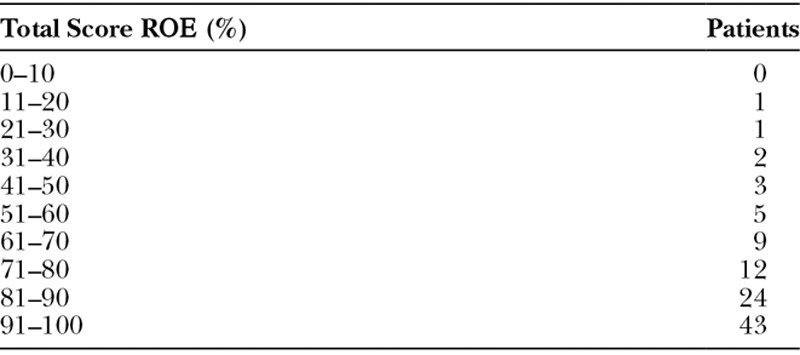
Table 3.
Distribution of Patients

Fig. 1.
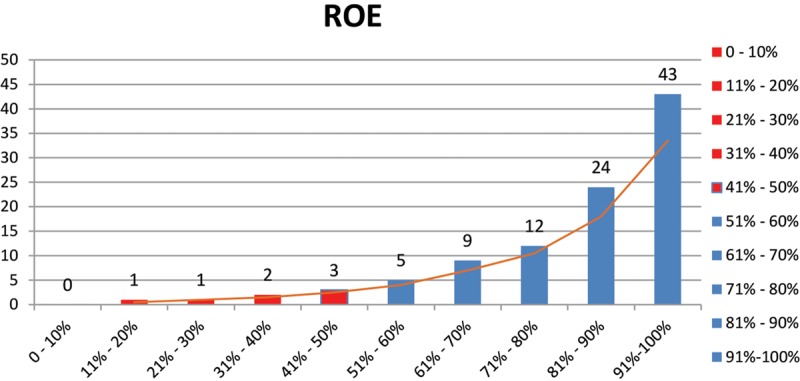
Distribution of patients according to total score.
Results show that the vast majority of patients (93) is satisfied with scores > 50% and only 7 patients had scores < 50%. In more details, 43 patients had scores between 90–100%, considering the result an absolute success, 24 patients between 81–90% being very satisfied, 12 patients with scores between 71–80% with satisfied results, and the rest of the scores were 61–70% (9 patients) and 51–60% (5 patients). On the opposite side, there were 3 patients being slightly disappointed (41–50%), 2 patients with scores 31–40%, 1 patient with score 21–30%, and 1 patient with score 11–20%.
The following table shows the descriptive statistics of the sample. The mean score was 82.45 ± 1.76 with a median of 87.5 (Table 4).
Table 4.
Descriptive Statistics of Sample ROE Total Scores
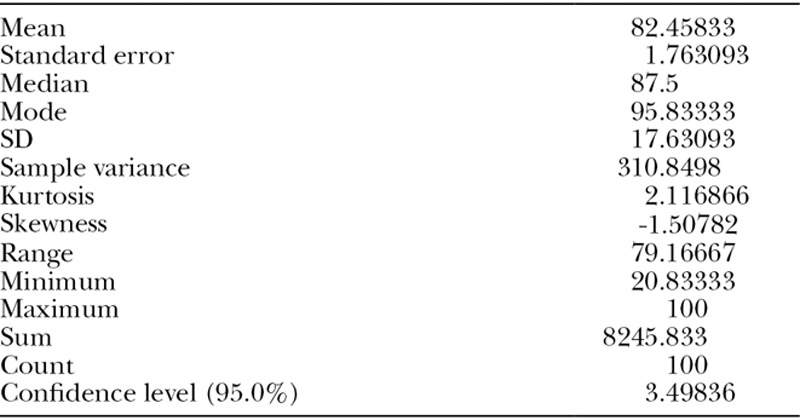
Scores Per Question
ROE—First Question
The majority of patients (94) are absolutely satisfied or very satisfied by how they like the shape of their nose (Table 5). Only 2 patients liked the result more or less and 4 patients did not like the final shape (Fig. 2).
Table 5.
ROE—First Question

Fig. 2.
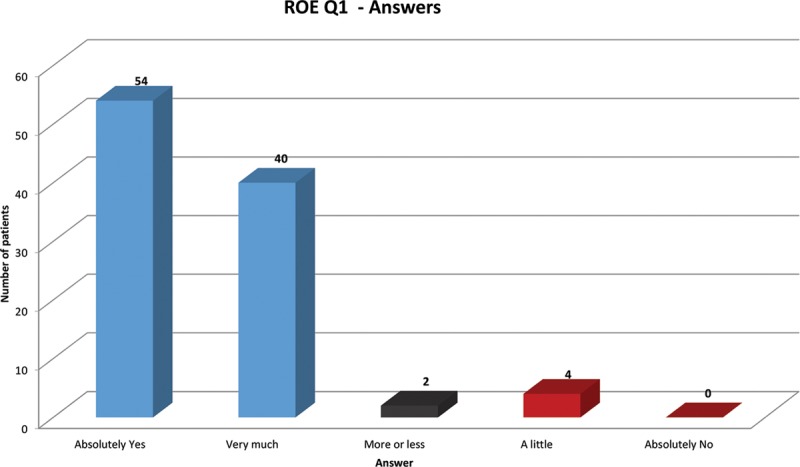
Answers/number of patients for the first question.
ROE—Second Question
Results showed that the majority of patients (81) are absolutely or very satisfied by their nasal breathing (Table 6). More or less 10 patients had the same breathing, whereas 7 patients had impaired breathing and 2 were absolutely disappointed by their nasal breathing (Fig. 3).
Table 6.
ROE—Second Question

Fig. 3.
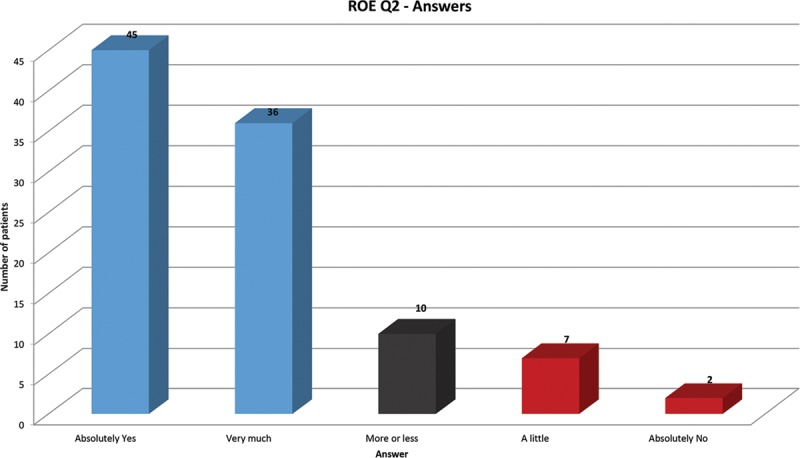
Answers/number of patients for the second question.
ROE—Third Question
Results showed that 92 patients were absolutely or very satisfied by how their close social circle likes their nose appearance (Table 7). Only 5 patients did not notice any change and 3 patients believe that the shape of their nose looks worse to their close social circle (Fig. 4).
Table 7.
ROE—Third Question

Fig. 4.
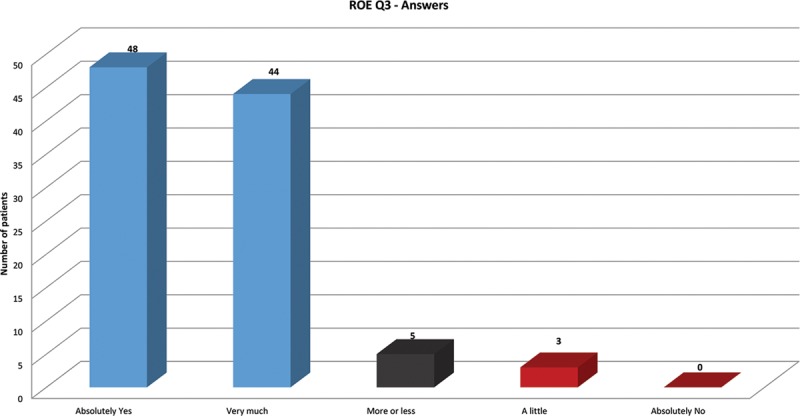
Answers/number of patients for the third question.
ROE—Fourth Question
The majority of patients (87) answered that never or rarely the shape of their nose hampers their social or professional activities (Table 8). Eleven patients answered sometimes, and only 2 patients answered frequently (Fig. 5).
Table 8.
ROE—Fourth Question

Fig. 5.
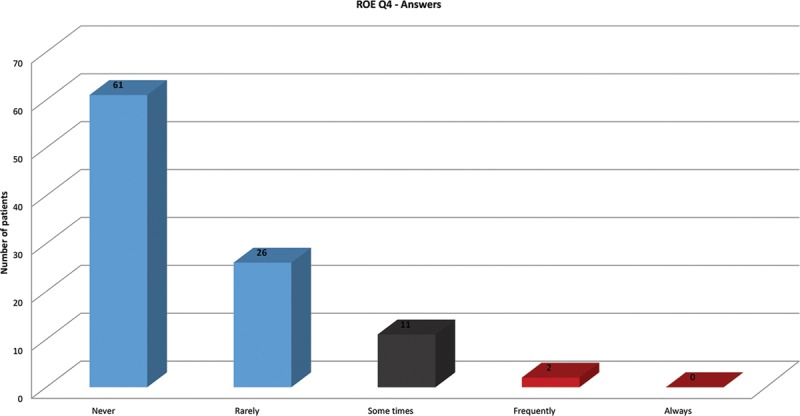
Answers/number of patients for the fourth question.
ROE—Fifth Question
The majority of patients (89) responded that they are absolutely or very satisfied by the possible maximal aesthetic result (Table 9). Four patients responded more or less, 6 patients a little, and only 1 patient absolutely no (Fig. 6).
Table 9.
ROE—Fifth Question

Fig. 6.
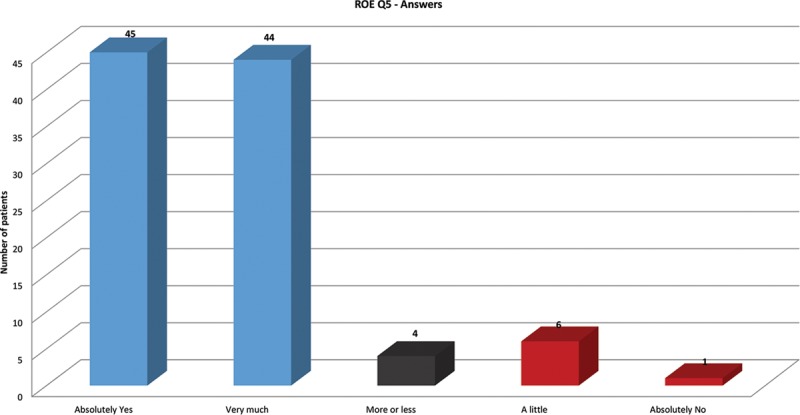
Answers/number of patients for the fifth question.
ROE—Sixth Question
The majority of patients (77) answered that they would not certainly or probably (not) would not undergo new surgery to correct the nasal shape or the functional result (Table 10). Two patients responded possibly yes, 9 patients very likely yes, and 12 patients certainly yes (Fig. 7).
Table 10.
ROE—Sixth Question

Fig. 7.
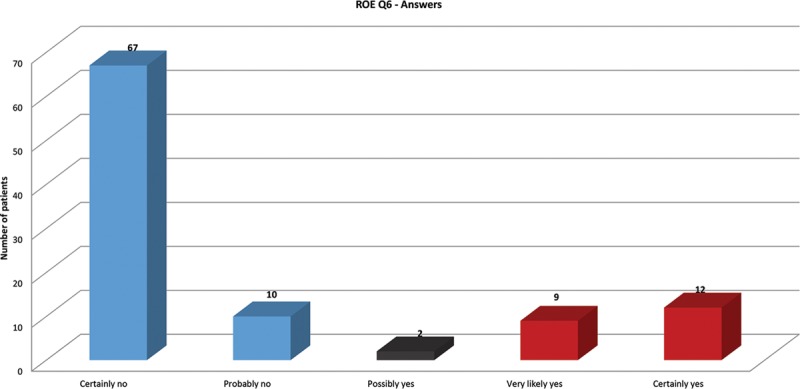
Answers/number of patients for the sixth question.
General Statistics
General statistics are provided in Table 11.
Table 11.
General Statistics

The following conclusions can be extracted by Table 11:
Women had higher mean scores than men with 85.4 instead of 78.7 and this difference is statistically significant (P = 0.03).
Despite the deleterious effects of smoking on both skin texture and nasal breathing, it appears surprisingly that smokers are more satisfied than nonsmokers with 84.5 instead of 79.5. However, the above difference was not statistically significant (P = 0.26).
It also appears that patients with allergic rhinitis are more satisfied than nonallergic patients with a mean score of 87 instead of 80.9, but this difference was also not statistically significant (P = 0.16).
The mean scores remain high within the age groups with a mean of 80.3 ± 2.23. However, the sample has a lower moving average toward the older groups as indicated also by sample’s skeweness (−0.7; Fig. 8).
The mean scores remain also high for the elapsed years since the operation with a mean score of 78.7 ± 3.18. However, it is worth mentioning that an average decline can be observed through the years. This decline can be accredited to the aging nose, or postoperative scaring processes, and to the fact that the sample is small and few unsatisfied patients accumulated in this specific period (only 7 patients were operated on and one of them was very unsatisfied with score 25, whereas the remaining had scores more than 70. Thus, this person may have affected considerably the mean score; Fig. 9).
Fig. 8.
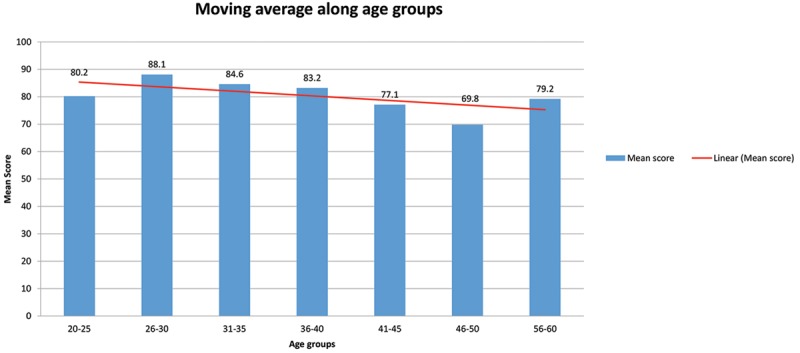
Distribution of results according to age groups.
Fig. 9.
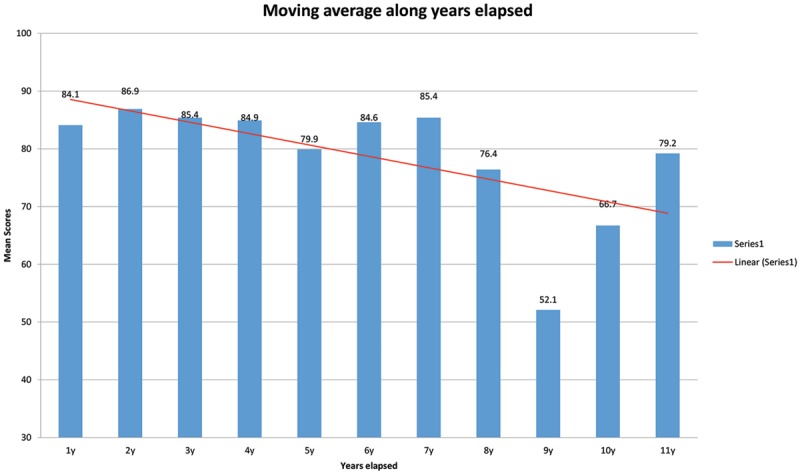
Distribution of scores according to years elapsed.
DISCUSSION
The results of the present study suggest that patients undergoing aesthetic rhinoplasty with the endonasal method have increased rates of satisfaction. There is no doubt that the nose is centrally positioned on the face, the most exposed body part, and is a basic component of patients’ face appearance—the actual view of ourselves. Thus, any kind of nasal deformity may cause high levels of psychological distress on the patient and affect his quality of life. This study proves that rhinoplasty can significantly alter the nasal appearance and improve quality of life. Results showed that 89 patients (89%) had total scores greater than 71%, which can be considered as very to absolutely satisfied. Results showed also that the satisfaction grade is high for both genders, smokers and nonsmokers as well as for allergic and nonallergic patients. In addition, it seems that is it also high (> 75%) for all ages except the group of 46–50 years old, which is unsafe to extract conclusions, as it was the smallest group in the study (n = 3). Finally, it seems that the satisfaction degree remains high for most years elapsed (> 75%), despite some small decline in the groups of 9 and 10 years elapsed, 52.1% and 66.7%, respectively.
One could say that the percentage of patients thinking about a revision rhinopalsty is high (23%) something that is opposite to the general score (only 7 patients had scores < 50%—dissatisfied). As mentioned above, this could be attributed to the aging nose or postoperative scaring effects. There are numerous publications addressing the topic of aging nose and aesthetic rhinoplasty.12–16 It is commonly known that the aging nose has altered structural characteristics for several reasons. As described by Rohrich et al.12,14 among them are the skin aging differences, the decreased cartilaginous support resulting in dropping of nasal tip or nasal valve and functional alterations resulting in secondary outcome dysfunctions. In addition, as described by Guyuron,13 the surgeon must have in mind the various incentives of those patients including psychological reasons, emotional status, and general tendency of the patients toward aesthetic operations. However, none of the above articles concluded that rhinopalsty in this age group is contraindicated or that results are unsatisfactory. It is strongly advised to have an extensive discussion with the patient before the operation explaining all the above issues. In addition, surgeons must perform a delicate operation with minimal bone fractures (if not at all) and gentle handling of the cartilages. Slight overcorrection of the tip is also advised as it is the most common point of observed deviations or drops.7 Also, always have in mind that spreader flaps are essential techniques for these kind of cases, due to enhancement of the nasal valve. At last, it is expected that older patients can be slightly less satisfied than younger patients due to the natural alterations of nasal framework.
In addition to the above observations, the same counts also for the postoperative long-term results. It is widely known that despite aging there is also postoperative scarring and adhesions that can alter the final result. Tip deviations of various grades, alterations in nares elasticity or shape and supratip adhesions can be the result of normal healing process, as described by Gassner et al.18 Thickness of the skin and hardness of the cartilaginous skeleton were the most important parameters to consider in these cases. Unfortunately, these are parameters that cannot be predicted by the surgeon and depend widely on the type of skin, age of person, and preoperative state of the nasal framework (previous traumatic fractures).19 However, the postoperative effects of the above scarring effects are not permanently progressing. From our experience, they can alter the nasal appearance up to maximum 1 year postoperatively, as it is something that cannot be assessed precisely due to the variance in healing process among patients. From this point on, there is a balance between postoperative effects and effects of the aging process. As it is obvious when years are elapsing, the nose is also “getting older” simultaneously. At last, many patients are satisfied in general, but they may need to alter some minor characteristics, like alar base excision, and so on. This could also explain the difference between the low number of unsatisfied patients (general score) and number of patients seeking revision (question 6).
Faidiga et al.5 performed a study of 62 patients with primary rhinoplasty and 7 with secondary by using ROE questionnaire. All patients had at least 1 year elapsed since their operation. Their results showed that the satisfaction of patients who underwent primary rhinoplasty was 73.25 ± 19.42% and of patients with secondary rhinoplasty 72.02 ± 15.54%. The study concludes that although rhinoplasties were performed by trainees, they still have very good results. It also concluded that ROE is a useful tool for rhinoplasty assessment. In the study of Arima et al.,19 the authors administered the ROE questionnaire to 19 patients who had undergone rhinoplasty for aesthetic reasons. The mean age was 37.9 years with 89.5% of patients being females and 10.5% males, and the mean observation time was 3.4 years. Their results showed that the mean preoperative score of all patients was 24.6 ± 11.3, whereas the postoperative score was 76.1 ± 19.5. They concluded that 100% of patients had improvement in their score postoperatively. Another study of Arima et al.7 administered ROE questionnaire to 61 patients with mean age of 33 years and mean time of follow-up 4.6 years. The mean score preoperatively was 27.2 ± 10.8, whereas postoperative score was 77.7 ± 17.2. They concluded again that 100% of patients noticed improvement in their aesthetic satisfaction and that younger groups had lower satisfaction rates than older.
A recent study performed by Islam et al.20 used ROE to assess 150 patients who underwent both open (group A, 100 patients) and closed (group B, 50 patients) rhinoplasty. The follow-up period varied between 6 months to 2 years. Their results showed that preoperative score from group A was 7.35 ± 3.3, whereas postoperative score was 62.5 ± 4.12; for group B, the scores were 18.03 ± 3.13 preoperatively and 42 ± 4.5 postoperatively. It seems that both groups had improvement postoperatively and that the group of endonasal approach had lower scores than open rhinoplasty group. At this point, though, it should be stressed that the 2 groups were unequal in number and this presents an obvious preference by the surgeons, toward open technique. Finally, Günel et al.21 studied a population of 58 patients who underwent aesthetic rhinoplasty by using ROE questionnaire. Their results showed that the preoperative score was 45, whereas postoperative score was 73.48 ± 16.06. The study concluded that rhinoplasty has strong positive results on aesthetic appearance and that it contributes significantly in raising quality of life.
The current study is also an attempt to identify possible interactions of the aesthetic result with other possible determinants of the outcome. One of the most important examined parameters is the elapsed time since the operation and its effect on the aesthetic result. The mean time between the operation and the observation point was 6.8 years, allowing the study to extract conclusions for the long-term effect of the operation. It is important for the nasal surgeons to know if the aesthetic result remains stable through time, especially for this anatomical area where gradual alterations occur with age. It is also important to know which age groups are mostly satisfied or which gender is more satisfied with the outcome; women were found more satisfied than men with a statistically significant difference.
CONCLUSIONS
The result of the present study suggests that rhinoplasty has high satisfaction rates with regard to the final aesthetic result. The grade of satisfaction remains high in both genders (although women were found more satisfied than men), in both smokers and nonsmokers as well as in both patients with allergic rhinitis and patients free of allergies. Finally, the aesthetic outcome appears to have a small decline within older patient groups or increased number of years elapsed due to postoperative effects and aging of the nasal tissue. Still though, satisfaction rates remain high. Results of the current study can trigger further research concerning aging and postoperative effects in combination.
ACKNOWLEDGMENTS
All procedures performed in studies involving human participants were in accordance with the ethical standards of the institutional and/or national research committee and with the 1964 Helsinki declaration and its later amendments or comparable ethical standards.
Footnotes
Disclosure: The authors have no financial interest to declare in relation to the content of this article. The Article Processing Charge was paid for by the authors.
REFERENCES
- 1.Ching S, Thoma A, McCabe RE, et al. Measuring outcomes in aesthetic surgery: a comprehensive review of the literature. Plast Reconstr Surg. 2003;111:469–80.; discussion 481. [DOI] [PubMed] [Google Scholar]
- 2.Kotzampasakis D, Piniara A, Themelis S, et al. Quality of life of patients who underwent aesthetic rhinoplasty: 100 cases assessed with the Glascow Benefit Inventory. Laryngoscope. 2017. [Epub ahead of print]. [DOI] [PubMed] [Google Scholar]
- 3.Alsarraf R. Outcomes research in facial plastic surgery: a review and new directions. Aesthetic Plast Surg. 2000;24:192–197.. [DOI] [PubMed] [Google Scholar]
- 4.Alsarraf R, Larrabee WF, Jr, Anderson S, et al. Measuring cosmetic facial plastic surgery outcomes: a pilot study. Arch Facial Plast Surg. 2001;3:198–201.. [DOI] [PubMed] [Google Scholar]
- 5.Faidiga GB, Carenzi LR, Yassuda CC, et al. Long-term evaluation in aesthetic rhinoplasty in an academic referral center. Braz J Otorhinolaryngol. 2010;76:437–441.. [DOI] [PMC free article] [PubMed] [Google Scholar]
- 6.Picavet VA, Gabriëls L, Grietens J, et al. Preoperative symptoms of body dysmorphic disorder determine postoperative satisfaction and quality of life in aesthetic rhinoplasty. Plast Reconstr Surg. 2013;131:861–868.. [DOI] [PubMed] [Google Scholar]
- 7.Arima LM, Velasco LC, Tiago RS. Influence of age on rhinoplasty outcomes evaluation: a preliminary study. Aesthetic Plast Surg. 2012;36:248–253.. [DOI] [PubMed] [Google Scholar]
- 8.Byrne M, Chan JC, O’Broin E. Perceptions and satisfaction of aesthetic outcome following secondary cleft rhinoplasty: evaluation by patients versus health professionals. J Craniomaxillofac Surg. 2014;42:1062–1070..24581635 [Google Scholar]
- 9.CioffiIzuI S, KosugiII EM, Brandão KV, et al. Normal values for the Rhinoplasty Outcome Evaluation (ROE) questionnaire. Braz J Otorhinolaryngol. 2012;78. [DOI] [PMC free article] [PubMed] [Google Scholar]
- 10.Bulut OC, Plinkert PK, Wallner F, et al. Quality of life in functional rhinoplasty: rhinoplasty outcomes evaluation German version (ROE-D). Eur Arch Otorhinolaryngol. 2016;273:2569–2573.. [DOI] [PubMed] [Google Scholar]
- 11.Izu SC, Kosugi EM, Lopes AS, et al. Validation of the Rhinoplasty Outcomes Evaluation (ROE) questionnaire adapted to Brazilian Portuguese. Qual Life Res. 2014;23:953–958.. [DOI] [PubMed] [Google Scholar]
- 12.Rohrich RJ, Hollier LH, Jr, Janis JE, et al. Rhinoplasty with advancing age. Plast Reconstr Surg. 2004;114:1936–1944.. [DOI] [PubMed] [Google Scholar]
- 13.Guyuron B. The aging nose. Dermatol Clin. 1997;15:659–664.. [DOI] [PubMed] [Google Scholar]
- 14.Rohrich RJ, Hollier LH. Rhinoplasty with advancing age. Characteristics and management. Clin Plast Surg. 1996;23:281–296.. [PubMed] [Google Scholar]
- 15.Moody M, Ross AT. Rhinoplasty in the aging patient. Facial Plast Surg. 2006;22:112–119.. [DOI] [PubMed] [Google Scholar]
- 16.Winkler AA, Downs BW. Aging male rhinoplasty. Facial Plast Surg Clin North Am. 2008;16:329–35, vi.. [DOI] [PubMed] [Google Scholar]
- 17.Quatela VC, Kolstad CK. Creating elegance and refinement at the nasal tip. Facial Plast Surg. 2012;28:166–170.. [DOI] [PubMed] [Google Scholar]
- 18.Gassner HG, Remington WJ, Sherris DA. Quantitative study of nasal tip support and the effect of reconstructive rhinoplasty. Arch Facial Plast Surg. 2001;3:178–184.. [DOI] [PubMed] [Google Scholar]
- 19.Arima LM, Velasco LC, Tiago RS. Crooked nose: outcome evaluations in rhinoplasty. Braz J Otorhinolaryngol. 2011;77:510–515.. [DOI] [PMC free article] [PubMed] [Google Scholar]
- 20.Islam S, Yousuf A. A comparative analysis of rhinoplasty open vs endonasal approach—our experience. Imp J Interdisciplinary Res. 2016;2:386–393.. [Google Scholar]
- 21.Günel C, Omurlu IK. The effect of rhinoplasty on psychosocial distress level and quality of life. Eur Arch Otorhinolaryngol. 2015;272:1931–1935.. [DOI] [PubMed] [Google Scholar]


